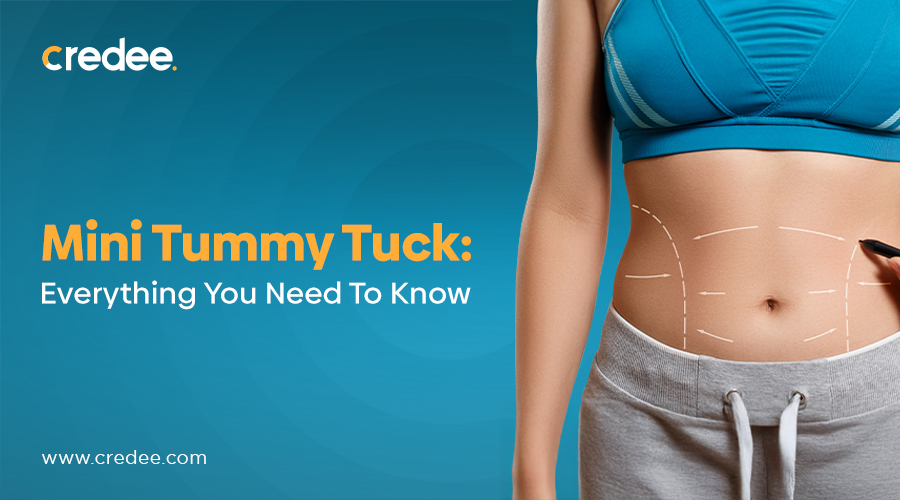
A panniculectomy is ideal for candidates who have severe weight loss after bariatric surgery or related procedures. Whereas a tummy tuck, or abdominoplasty, is a good option for anyone with moderate weight loss, especially for women after pregnancy.
The two procedures address similar challenges: help remove the excessive/saggy skin after weight loss, contour the abdomen, and achieve a flat and smooth tummy. However, the cost of both procedures, treatment techniques, and recovery times differ vastly.
Dive in to learn the difference between panniculectomy vs. tummy tuck, their advantages, the costs of each procedure, and how to pay for it.
How Is Tummy Tuck Different From Panniculectomy?
Panniculectomy is a type of loose skin removal surgery performed on the substantially overhanging abdominal skin, i.e., lower tummy or panniculus. This procedure is often considered medically necessary if the excessively sagging skin is causing health issues. It is commonly performed after significant weight loss following bariatric surgery, gastric bypass, or even pregnancy.
A tummy tuck is typically performed after pregnancy-related weight loss and is frequently included in the "Mommy Makeover". While this may not result in a six-pack figure, it can significantly improve your visual look. It helps remove excess abdominal skin and contour the tummy for a smooth torso.
Though the two procedures may provide somewhat similar results, there are various prominent differences.
Panniculectomy Vs. Tummy Tuck: Key Differences
| Criteria | Panniculectomy | Tummy Tuck |
|---|---|---|
| Medical Necessity | May be considered medically necessary | Elective procedure, hence, considered as cosmetic surgery |
| Average Cost | Between $8,000–$15,000+ | $5,000–$11,000+ |
| Insurance Coverage | Can be covered by insurance | No insurance coverage |
| Success Rate | High success rate similar to tummy tuck surgery | Similar success rates to panniculectomy |
What To Expect: Comparing Panniculectomy Vs. Tummy Tuck
| Panniculectomy | Tummy Tuck | |
|---|---|---|
| Before Surgery | - Pre-surgery consultations - Patients need to provide evidence for insurance approval - Doctor-recommended tests | - Pre-surgery consultations and discussing aesthetic expectations/goals - Out-of-pocket expenses are discussed - The surgeon may offer flexible payment options |
| During Surgery | - Surgical removal of excess skin and fat from the lower abdomen - Performed under general anesthesia - The procedure may take 2-5 hours | - Also done under general anesthesia - Involves removing excess skin and the abdominal muscles are tightened - Liposuction may be used for contouring - The surgery usually lasts 2-4 hours |
| After Surgery | - Pain, numbness, swelling, and scarring are common (they fade over time) - Patients are required to wear a compression garment to reduce swelling - Restrictions on physical activities - Follow-up visits are essential for monitoring recovery | - Similar to panniculectomy pain, numbness, swelling, and scarring (fades over time) - Patients need to wear a compression garment - Avoid strenuous activity - Follow-up visits are important for tracking progress |
| Risks/Side Effects | - The risk of complications is generally low but rare complications include infection, bleeding, or poor wound healing. | - Complications are rare but may include infection, bleeding, fluid accumulation, or other post-op concerns. |
| Recovery Time | - 4-6 weeks to 3 months for recovery - Complete healing to achieve the final results may take a few months to 2 years | - Recovery may be slightly more uncomfortable - 6-8 weeks average recovery time - Final results show within 3-6 months to a year |
Average Cost Of Panniculectomy Vs. Tummy Tuck In Different Cities
| City | State | Panniculectomy (Average Cost) | Tummy Tuck(Average Cost) |
|---|---|---|---|
| Beverly Hills | California | $8,000–$15,000 | $3000–$12,000 |
| Brooklyn | New York | $8,000–$15,000 | $6,000–$11,000 |
| Houston | Texas | $7,000–$15,000 | $8,200–$12,000 |
| Miami | Florida | $8,000–$15,000 | $3,500–$10,000 |
| Chicago | Illinois | $8,000–$15,000 | $6,154–$13,000 |
| Philadelphia | Pennsylvania | $8,500–$15,000 | $5,000–$18,000 |
| Cleveland | Ohio | $8,000–$15,000 | $5,000–$11,500 |
| Los Angeles | California | $7,000–$15,000 | $4,000–$20,000 |
| Atlanta | Georgia | $7,600–$15,000 | $6,000–$12,500 |
| San Jose | California | $8,500–$15,000 | $10,000–$15,000 |
| Charlotte | North Carolina | $8,000–$15,000 | $8,500–$15,000 |
| Tampa | Florida | $8,500–$15,000 | $5,000–$11,000 |
| Raleigh | North Carolina | $9,135–$13,000 | $6,500–$10,000 |
| Detroit | Michigan | $8,500–$15,000 | $5,000–$15,000 |
| Dallas | Texas | $8,000–$15,000 | $8,500–$12,000 |
| Newark | New Jersey | $8,500–$15,000 | $6,000–$15,000 |
| Seattle | Washington | $8,500–$15,000 | $6,200–$13,000 |
| Phoenix | Arizona | $11,200–$17,000 | $7,000–$15,000 |
| Boston | Massachusetts | $9,000–$17,000 | $4,000–$18,000 |
| Richmond | Virginia | $10,000–$15,000 | $7,000–$12,000 |
| Cincinnati | Ohio | $8,000–$15,000 | $5,000–$11,000 |
| Indianapolis | Indiana | $10,000–$15,000 | $7,500–$9,500 |
| Memphis | Tennessee | $8,000–$15,000 | $8,250–$10,500 |
| Nashville | Tennessee | $8,000–$15,000 | $8,000–$10,500 |
| St. Louis | Missouri | $11,000–$12,500 | $6,500–$14,000 |
| Milwaukee | Wisconsin | $6,000–$15,000 | $5,000–$14,000 |
| Baltimore | Maryland | $8,000–$15,000 | $8,000–$11,600 |
| Denver | Colorado | $8,500–$15,000 | $7,000–$20,000 |
| Louisville | Kentucky | $8,000–$15,000 | $5,000–$11,000 |
| Minneapolis | Minnesota | $8,500–$15,000 | $7,000–$11,000 |
| Columbus | Ohio | $8,500–$15,000 | $6,500–$11,000 |
| Charleston | South Carolina | $10,000–$15,000 | $6,600–$12,500 |
| Portland | Oregon | $8,500–$15,000 | $7,000–$12,000 |
| Oklahoma City | Oklahoma | $7,500–$15,000 | $8,500–$12,500 |
| Las Vegas | Nevada | $9,500–$20,000 | $7,500–$12,000 |
| Bridgeport | Connecticut | $8,000–$24,000 | $8,300–$18,000 |
| New Orleans | Louisiana | $7,900–$18,000 | $5,000–$15,000 |
| Salt Lake City | Utah | $8,000–$17,000 | $8,000–$13,000 |
| Birmingham | Alabama | $8,000–$15,000 | $5,500–$12,000 |
| Des Moines | Iowa | $7,500–$15,000 | $6,000–$12,000 |
| Little Rock | Arkansas | $11,000–$15,000 | $6,000–$14,000 |
| Jackson | Mississippi | $6,200–$11,500 | $5,800–$7,500 |
| Omaha | Nebraska | $8,200–$15,000 | $6,000–$12,000 |
| Albuquerque | New Mexico | $8,000–$16,500 | $7,600–$15,700 |
| Charleston | West Virginia | $9,900–$15,000 | $8,200–$14,000 |
| Honolulu | Hawaii | $6,000–$20,000 | $10,000–$20,000 |
| Boise | Idaho | $8,000–$15,000 | $7,000–10,000 |
| Portland | Maine | $5,500–$17,000 | $7,000–$12,000 |
| Manchester | New Hampshire | $12,000–$15,000 | $4,000–$18,000 |
| Burlington | Vermont | $9,000–$17,000 | $6,000–$14,500 |
| Wilmington | Delaware | $8,000–$15,000 | $4,500–$20,000 |
Other Factors Affecting The Cost:
| Factors | Average Cost |
|---|---|
| Surgeon’s Fees | $7,000–$9,000 (usually included in the overall cost) |
| Facility Costs | $1,000–$3,000 |
| Medical Testing | $200–$500 |
| Anesthesia | $500–$1,000 |
| Follow-Up Visit and Medications | $100–$300 |
Are There Any Financing Options When Insurance Doesn't Cover The Cost?
Yes, here are some of the popular financing options to help you pay more easily:
1. Medical Credit Cards
Many healthcare providers nowadays accept medical credit cards such as CareCredit and Sunbit. These offer a convenient way to finance a range of medical and cosmetic procedures, including panniculectomy and tummy tuck. You can qualify for these cards if you have a good credit score (typically 620 or higher).
2. Flexible Payment Plans
Many healthcare providers also recognize that credit checks may limit access to easy financing. Hence, they offer alternatives such as Credee flexible payment plans to help patients spread the cost of surgery over time. Hence, you can get approved without credit checks and make easy monthly payments. This type of financing gives you more options regardless of your financial situation. So it's best to discuss your payment preferences with the surgeon upfront.
3. Medical Loans
Traditional payment methods, such as financing from banks, or other loan providers can also be another option. These loans typically have a fixed rate and rigid repayment requirements. Moreover, they usually require a hard credit check for approval. So, they can be a good option for larger medical expenses not covered by insurance when you have a desirable credit standing.
Final Thoughts
Both the panniculectomy and tummy tuck surgery help remove the unwanted fat from the abdomen. It not only improves your abdomen’s appearance but also improves your quality of life and confidence. However, before taking this step, it's crucial to plan financially and explore your insurance and financing options.
FAQs
1. How Much Does A Panniculectomy vs. Tummy Tuck Cost?
The national average cost for a panniculectomy in the U.S. is $9,678 though the price can fluctuate between $8,000–$15,000 based on the location. Whereas, the average tummy tuck price is $8,174 as per the latest statistics. Although, realistically speaking, it can cost anywhere around $6,000–$11,500 to a maximum of $24,000.
2. How To Get A Panniculectomy Covered By Insurance?
For this, you need to satisfy the following:
- Provide sufficient medical records, i.e., documentation to prove that the procedure is medically necessary.
- If the weight condition is impacting your quality of life and causing physical health issues such as skin infections, rashes, etc.
- You may also need to maintain a stable weight following the bariatric procedure for a specified period, i.e., 6–18 months.
- You should also consult with your insurance provider to know the extent of coverage beforehand to prepare financially to handle out-of-pocket expenses.
3. Which Is More Expensive: Panniculectomy or Tummy Tuck?
Panniculectomy skin removal surgery has a higher price tag, but it is often covered by insurance due to its medical necessity. This results in a much lower out-of-pocket cost. However, tummy tuck isn’t covered by insurance at all, which makes it a more expensive option.
4. What Are The Best Financing Options For A Tummy Tuck?
It’s a cosmetic procedure and isn’t usually covered by insurance, so you may need to explore financing options first. There are several options like a loan, CareCredit, or another medical credit card. But if you want to avoid the credit check, Credee payment plans are your best option. Credee does not require any credit checks and approves 97% of applicants instantly. So, you can discuss this option with your surgeon during the initial consultation.

Want To Know More About How Credee Financing Works?
Book A Demo Now



